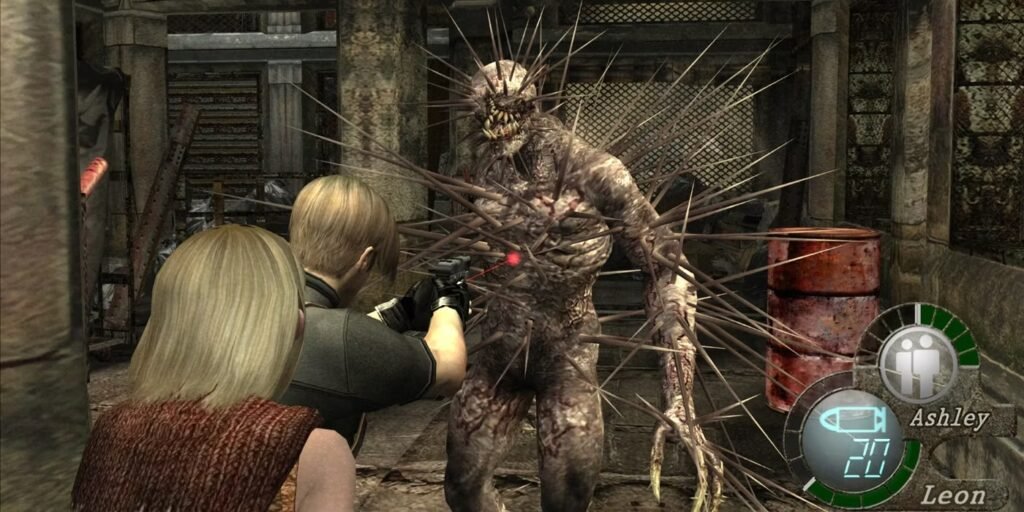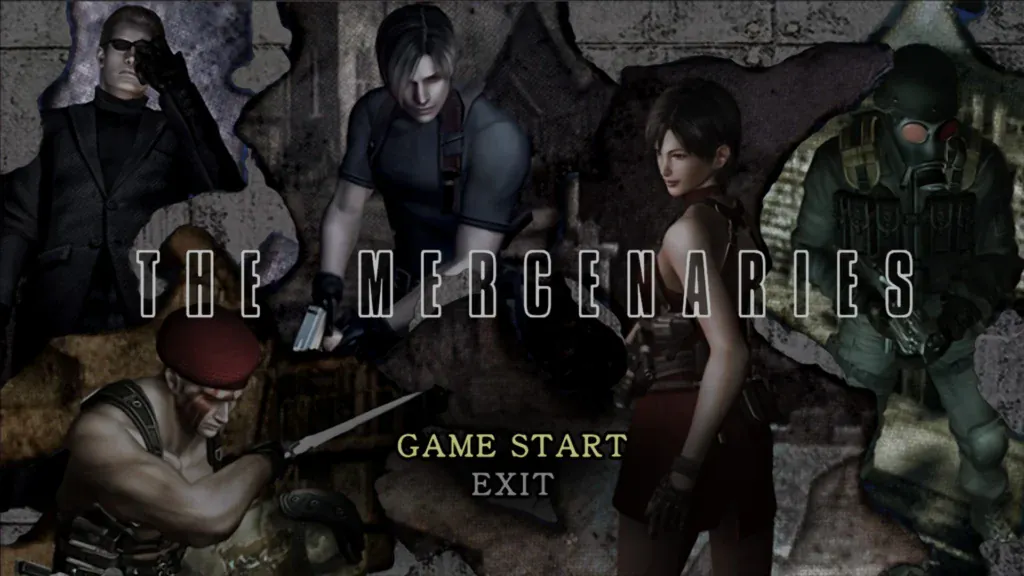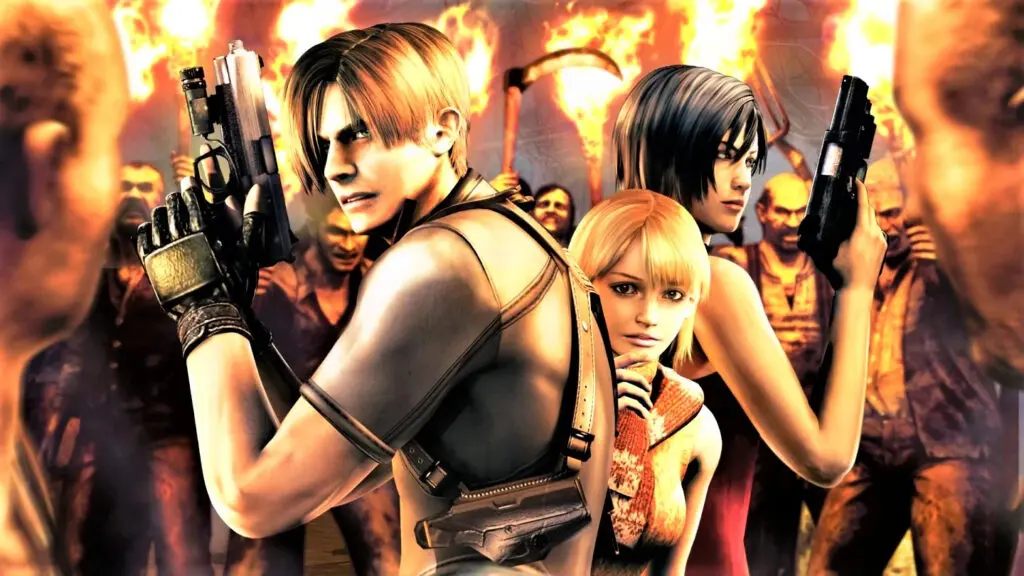Resident Evil 4 marked a significant departure from the traditional survival horror gameplay of the previous entries in the series. With a fresh perspective (both story-wise and camera-wise), it revitalised the franchise and became one of the most influential games of its generation, and arguably still the best in the series. The PlayStation 2 version, released in October 2005.
On This Page

Story
The game follows Leon S. Kennedy, a protagonist from Resident Evil 2, no longer a police rookie, now a leather jacket wearing U.S. government agent tasked with rescuing Ashley Graham, the President’s daughter. Ashley has been kidnapped by a mysterious cult in rural Spain. The story unfolds in a series of typically Resident Evil-esque distinct environments, from eerie villages to ancient castles to creepy labs, blending gothic horror with action-packed sequences.
Leon S. Kennedy is dispatched to a remote village in Spain to rescue Ashley Graham, the President’s kidnapped daughter. The mission seems straightforward, but Leon soon discovers the village is plagued by a mysterious cult and an oddly familiar parasitic infection.
There can’t be many gamers who haven’t played this game or its recent remake so below is an abridged version of the story picking out the key details.

Chapter 1: The Village
- Editors note: sure to save the dog from the bear trap, even without him helping you later in the game…just save the dog.
1. Arrival and First Encounter: Leon arrives in the village and encounters hostile villagers, known as Ganados, who are infected with the Las Plagas parasite. One of the most iconic missions in gaming history has you fight off a town of infected villagers before making your escape to the rooftops. This sets the tone for the gameplay changes Resident Evil 4 has made,
2. Rescue Luis Sera: Leon rescues Luis Sera, a former researcher for the cult who provides vital information about Las Plagas.
3. Face-Off with Chief Bitores Mendez: Leon confronts and escapes from the village chief, Mendez, who demonstrates superhuman abilities.
Boss Battle: Del Lago, a giant aquatic creature that Leon must defeat while crossing a lake.

Chapter 2: The Church and Ashley
1. Find the Church: Leon fights through hordes of Ganados to reach a church where Ashley is held captive.
2. Rescue Ashley: Leon rescues Ashley from the church. She becomes a key companion, and Leon must protect her throughout the game. (this is not as fun as it sounds).
3. Escape the Village: Leon and Ashley make their way through the village, avoiding traps and enemies, and eventually reach the castle of Ramón Salazar.
Boss Battle: El Gigante, a towering giant Leon must defeat to progress.
Chapter 3: The Castle
1. Entering the Castle: Leon and Ashley enter the castle, facing new enemies, including zealots and monstrous creatures.
2. Encounter with Ramón Salazar: Salazar, the castle’s diminutive and sadistic ruler, taunts Leon and Ashley and sends various minions after them.
3. Separate Ways: Ada Wong, a mysterious agent with her own agenda, assists Leon indirectly and directly, revealing her connection to the events.
Boss Battle: Verdugo, Salazar’s fearsome bodyguard, who Leon must either fight or evade in a tense confrontation.
Chapter 4: The Rescue Continues
1. Deeper into the Castle: Leon navigates through intricate traps and puzzles, fighting tougher enemies, including armoured knights and insect-like Novistadors.
2. Separation: Ashley is captured again, and Leon must find a way to rescue her from her captors.
3. Laboratory Discoveries: Leon discovers more about the Las Plagas parasites and the cult’s plans in a hidden lab within the castle.
Boss Battle: Ramón Salazar, who mutates into a grotesque creature that Leon must defeat.

Chapter 5: The Island
1. Reach the Island: Leon and Ada arrive on an island, which serves as the cult’s research facility and stronghold.
2. Regenerator Research: Leon encounters terrifying Regenerators and learns more about their connection to the Las Plagas parasite.
3. Rescue and Escape: Leon rescues Ashley from a high-security area and prepares for the final confrontation.
Boss Battle: Krauser, a former comrade of Leon’s, who is now working for the cult. Their duel is intense and personal.
Final Chapter: The Showdown
1. Confrontation with Saddler: Leon faces off against Osmund Saddler, the cult’s leader, who has been orchestrating the events from behind the scenes.
2. Ashley’s Rescue: Leon successfully administers a treatment to Ashley to remove the Las Plagas parasite from her body.
3. Escape from the Island: After defeating Saddler, Leon and Ashley escape the island on a jet ski as the facility self-destructs.
Final Boss Battle: Osmund Saddler, who transforms into a monstrous form for the final showdown.
Epilogue
1. Safe Return: Leon and Ashley safely return to the United States.
2. Ada’s True Motives: Ada Wong’s true motives are hinted at as she makes her escape with a sample of the Las Plagas parasite.
3. Future Implications: The game ends with hints of future threats and the continued danger posed by bioterrorism.
Additional Content: Separate Ways
Ada’s Perspective:
1. Parallel Story: The Separate Ways campaign offers a parallel narrative from Ada Wong’s perspective, revealing her interactions with Leon and her objectives.
2. Insight into the Cult: Ada’s missions provide additional context about the cult and their experiments with Las Plagas.
3. Final Encounter: Ada’s story concludes with her escape from the island, securing the Las Plagas sample for her mysterious employer.
Gameplay Mechanics
The most notable change in Resident Evil 4 is the switch to an over-the-shoulder camera, providing a more immersive and dynamic shooting experience. This perspective allowed for precise aiming and added tension during combat, as players could no longer rely on fixed camera angles.
The game introduced a more action-oriented approach with a robust combat system. Players could target specific body parts of enemies, leading to varied reactions and strategies. The inventory system was also revamped, utilising an attaché case with a grid-based layout for managing weapons, ammunition, and items.
Quick-time events (QTEs) were integrated into both combat and cutscenes, requiring players to press buttons rapidly or in sequence to survive encounters or avoid traps. This mechanic kept players engaged during non-interactive moments and added an extra layer of challenge and has become a staple in Resident Evil games.
The game’s enemies, particularly the parasitic Ganados, exhibited more intelligent behaviours compared to previous titles. They could coordinate attacks, wield weapons, and even dodge incoming fire. The variety of enemies, including the terrifying Regenerators and towering bosses, ensured a consistently engaging and unpredictable experience.
Graphics and Sound
Despite the limitations of the PlayStation 2 hardware compared to the GameCube, Resident Evil 4 maintained impressive visuals. The game’s environments were richly detailed, with atmospheric lighting and weather effects enhancing the sense of immersion. Character models and animations were also top-notch, contributing to the overall polish.
The sound design played a crucial role in creating a tense atmosphere. The eerie ambient noises, distant whispers, and sudden musical cues heightened the sense of dread. Voice acting was strong, with standout performances from Leon and other key characters, though some of the dialogue veered into campy territory.
Additional Content and Features
The PlayStation 2 version of Resident Evil 4 included several enhancements over the original GameCube release:
Separate Ways Campaign:
This additional campaign followed Ada Wong, offering insights into her role in the main story and providing new gameplay perspectives.
Extra Costumes and Weapons:
Players could unlock new outfits for Leon and Ashley, as well as powerful weapons like the Chicago Typewriter and the Infinite Rocket Launcher.
Mercenaries Mode:
This mode challenged players to defeat as many enemies as possible within a time limit, featuring various characters and stages from the main game.

Reception and Legacy
Resident Evil 4 received universal acclaim, with praise directed at its innovative gameplay, compelling narrative, and high production values. It won numerous Game of the Year awards and is often cited as one of the greatest video games of all time.
Conclusion
Resident Evil 4 on the PlayStation 2 remains a landmark title in the survival horror genre and a testament to Capcom’s ability to innovate and captivate players. Its impact on game design and its enduring popularity ensure that it will be remembered as a classic for years to come.

Joys
- The iconic Resident Evil Title
- Fantastic Story
- Great Combat
Cons
- Constantly saving Ashley gets really annoying



